Exploring the Ultraviolet Light Test: Insights and Uses
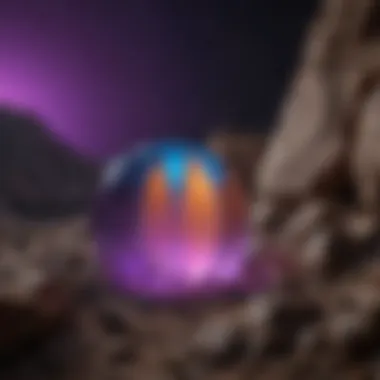

Intro
The ultraviolet light test offers a unique insight into the world of minerals and fossils. It provides a method that goes beyond mere visual examination. Ultraviolet light reveals properties and characteristics that are often hidden under natural light conditions. This article examines how the ultraviolet light test works, its applications in geology and paleontology, and how collectors can utilize this valuable tool.
Understanding this test is crucial for rock and fossil collectors who wish to expand their knowledge. The information gathered through the ultraviolet light test can ultimately change how specimens are viewed and preserved.
Featured Collectible of the Month
Overview
For this month, we spotlight the fluorite mineral. Fluorite exhibits distinct fluorescence under ultraviolet light. The color of fluorite can vary based on its impurities. When examined under ultraviolet light, fluorite can show various glowing colors, providing insight into its composition and origin. This property makes it a prized collectible among enthusiasts.
Historical Significance
Fluorite has a rich history, with artifacts dating back to ancient civilizations. The mineral has been utilized in various ways throughout history, including as a flux in metal production. Its striking appearance and interesting properties have made it a subject of fascination for scientists and collectors alike.
Identification Techniques
When using ultraviolet light for identification, there are several techniques that can enhance understanding of mineral specimens.
Visual Characteristics
- Fluorescence: Observe the glow of the mineral under UV light. Color intensity and hue can indicate purity or impurities present.
- Texture Changes: Some specimens might show alterations in texture when viewed in UV light. This can assist in identifying specific types of minerals or fossil materials.
- Patterns: Look for unique patterns that may emerge due to UV reactions.
Resources for Identification
- Wikipedia: Fluorescence in Minerals
- Britannica: Fluorite as a Mineral
- Reddit: Forums for collectors discussing UV tests and techniques (reddit.com)
- Facebook Groups: Join communities focused on mineral and fossil collecting to share experiences and techniques.
Exploring ultraviolet light testing can yield invaluable insights into your collections. This non-invasive method empowers collectors, enhancing appreciation for both minerals and fossils.
The End
The ultraviolet light test is a significant tool for rock and fossil collectors. Mastering its principles and applications can greatly enhance both identification processes and appreciation for geological specimens. Understanding how and when to use this test allows collectors to deepen their expertise and enjoyment of their collections.
Preface to Ultraviolet Light
Understanding ultraviolet light is not just essential for scientists but also for enthusiasts in geology and paleontology. This topic serves as a gateway to exploring how ultraviolet light can aid in the identification and analysis of minerals and fossils. Its applications reveal a new dimension in the study of geological specimens, offering insight that might otherwise remain hidden. This introduction provides the foundation for the discussions that will follow, outlining the characteristics and significance of ultraviolet light in scientific exploration.
Defining Ultraviolet Light
Ultraviolet light, often abbreviated as UV light, refers to a type of electromagnetic radiation with wavelengths shorter than visible light but longer than X-rays. The UV spectrum is divided into three categories: UVA, UVB, and UVC, each having distinct properties and implications for several scientific studies. UVA rays, which have the longest wavelength, are present in sunlight and can penetrate the skin deeply, potentially causing skin damage. UVB rays are responsible for causing sunburns and have a more limited range of penetration. UVC rays, on the other hand, are entirely absorbed by the Earth’s ozone layer and do not appear in sunlight at the surface. This segment will focus on how defining ultraviolet light lays the groundwork for understanding its principles in practical applications.
History of Ultraviolet Light Discovery
The journey of ultraviolet light began in the early 19th century. In 1801, the German physicist Johann Wilhelm Ritter discovered UV radiation while experimenting with the spectrum of light. He observed that silver chloride darkened more intensely beyond the violet end of the visible spectrum, indicating that there was an invisible light responsible for this reaction. This pivotal moment marked the first known instance of ultraviolet light detection.
As the 19th century progressed, further research into UV light intensified, leading to the development of early UV lamps and their applications. By the 20th century, the understanding of UV radiation expanded significantly, resulting in its incorporation into various fields including medicine, astronomy, and geology. This historical backdrop is vital for contextualizing the role of UV light as a tool in the analysis of fossils and minerals, fostering a deeper appreciation for its scientific significance.
Understanding the Ultraviolet Light Spectrum
The ultraviolet light spectrum plays a vital role in the ultraviolet light test. Understanding this spectrum is essential for effective application and accurate interpretation of the test results, particularly in fields such as geology and paleontology. By comprehending how ultraviolet light is categorized, collectors and researchers can make informed decisions about which type to utilize based on their specific objectives. Furthermore, familiarity with the spectrum allows enthusiasts to appreciate light's impact on various materials.
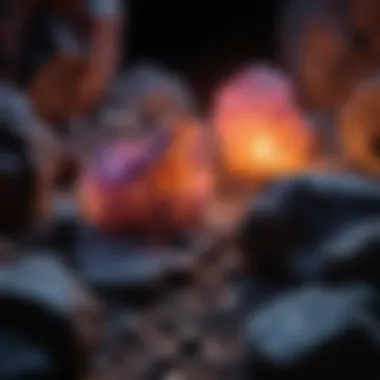
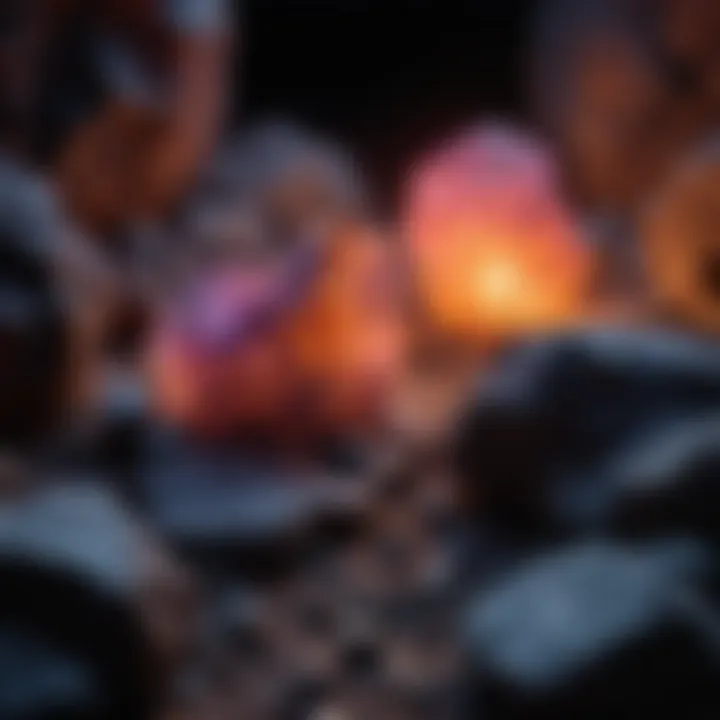
Classification of Ultraviolet Light
Ultraviolet light exists in different categories, with each serving distinct purposes and having unique characteristics. The classification includes three primary segments: UVA, UVB, and UVC.
UVA
UVA light is known for its longer wavelength, ranging from 320 to 400 nanometers. This category is crucial in many applications, particularly in geology, where it can effectively induce fluorescence in certain minerals. One key characteristic of UVA is that it penetrates deeper into materials compared to other types of ultraviolet light.
The beneficial aspect of UVA is its ability to offer clear identification of minerals that exhibit fluorescence under UV light. Its long wavelength ensures minimal damage to specimens during examination, making it ideal for researchers and collectors alike. However, it’s important to note that while UVA is versatile, its effectiveness can be limited in distinguishing between similar minerals.
UVB
UVB light ranges from 280 to 320 nanometers and is known for its more intense energy compared to UVA. This intensity can cause more significant reactions in materials, such as cracking or fading. A vital characteristic of UVB is its effectiveness in targeting organic compounds.
As a advantage, UVB can be more effective in revealing certain features of fossils and minerals, particularly those with organic components. However, the intensity of UVB can also lead to potential damage in delicate specimens, making careful usage essential when applying this wavelength.
UVC
UVC light, with wavelengths between 100 and 280 nanometers, is less frequently encountered outside specialized applications due to its high energy. UVC is notable for its ability to sterilize surfaces and materials, which has significant implications in various fields, including paleontology.
Its unique feature lies in its effectiveness at breaking down organic materials, making it a useful tool for examining the integrity of fossils. However, the downside of UVC is its potential harm both to living organisms and to many mineral specimens, making it necessary to use appropriate safety measures during its application.
Properties of Ultraviolet Rays
Ultraviolet rays come with specific properties that have implications on how they interact with different materials. Their ability to cause fluorescence, their energy levels, and their interactions with organic and inorganic compounds all contribute to the effectiveness of the ultraviolet light test. Understanding these properties helps improve the accuracy of the testing outcomes and ensures the sustainability of specimens.
Mechanism of the Ultraviolet Light Test
Understanding the mechanism of the ultraviolet light test is fundamental in grasping its various applications, especially in geology and paleontology. The test relies on the unique properties of ultraviolet light to analyze materials, helping professionals and collectors distinguish between different specimens, assess their integrity, and identify their authenticity. This section delves into the operational principles, the setup of instruments, and the necessary safety precautions associated with this testing method.
Operational Principles
The operational principles of the ultraviolet light test are based on the interactions between ultraviolet rays and the materials under examination. When exposed to UV light, certain minerals and fossils exhibit fluorescence, allowing for more straightforward identification. This occurs due to the absorption of UV radiation and subsequent re-emission at a different wavelength, commonly visible light.
Fluorescence reveals key characteristics about the specimen, such as its mineral composition or the presence of organic materials. Understanding this principle enables collectors to make informed decisions about their specimens, as fluorescence can indicate quality and authenticity.
Moreover, the specific UV spectrum used in testing affects the results. For instance, shortwave UV light might reveal different aspects of a specimen compared to longwave UV light. Thus, selecting the correct wavelength and understanding the interactions of light with materials are critical steps in the testing process.
Instrument Setup and Calibration
Setting up the instruments properly is crucial to achieve reliable test results. The main instrument used in ultraviolet light testing is the UV lamp. Various types of UV lamps are available, including mercury vapor lamps and LED-based devices. Each has distinct characteristics affecting their intensity and wavelength output.
Calibration is another essential element. Instruments must be calibrated regularly to ensure consistent performance. This can involve checking the output intensity of the light source and making necessary adjustments to maintain accurate readings. Accurate calibration helps avoid errors that can mislead assessment outcomes, enabling more precise identification of specimens.
Steps for Setup and Calibration:
- Select the Appropriate UV Lamp: Consider the type of analysis needed. For instance, if fluorescence is the primary focus, select a lamp with the correct wavelength range.
- Position the Lamp Correctly: The distance from the specimen should be appropriate to provide optimal exposure without causing damage.
- Check Calibration: Use a certified calibration standard to ensure the lamp's output is within recommended levels.
- Warm Up Period: Allow the lamp to warm up for the required time before commencing tests to avoid fluctuations in output.
Safety Precautions
Safety is paramount when conducting ultraviolet light tests, given the potential hazards posed by UV exposure. Both the operator and bystanders should take precautions to mitigate risks associated with ultraviolet radiation.
A fundamental safety measure involves wearing UV protective goggles, as regular eyewear does not provide adequate protection against UV light. Skin exposure should also be minimized. Operators should wear long sleeves and avoid direct exposure when possible to prevent skin damage.
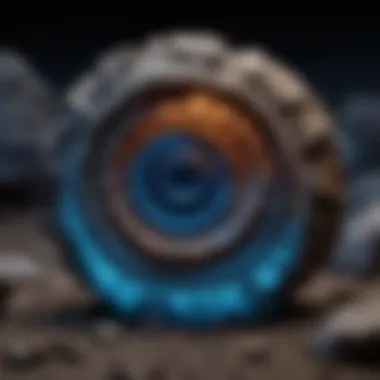
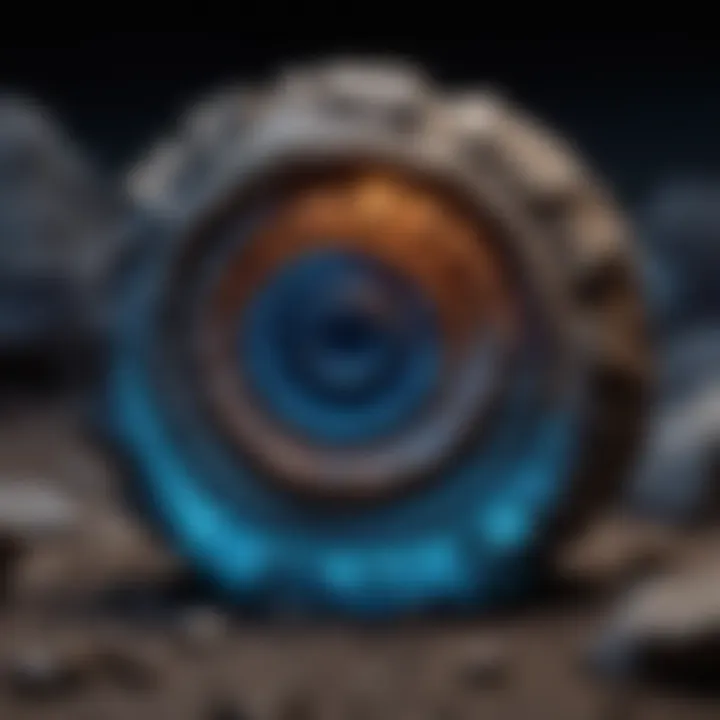
It is also important to ensure the workspace is adequately ventilated. Certain materials may emit harmful vapors when exposed to UV light, necessitating airflow to disperse any potential hazards.
Ultimately, understanding the mechanism of the ultraviolet light test, including its operational principles, the significance of instrument setup, and the importance of safety protocols, provides a comprehensive foundation for conducting effective examinations in geology and paleontology.
Applications in Geology and Paleontology
The applications of ultraviolet light testing in geology and paleontology are significant, as this technique provides essential insights into the properties of various materials. It aids in the identification and analysis of geological specimens, which is vital for both scientific research and for collectors. The ability of ultraviolet light to reveal information that is not visible under regular lighting enhances the understanding of mineral characteristics and fossil structures. This section emphasizes the specialized applications of ultraviolet light testing and how they benefit both professionals in the field and avid collectors.
Identifying Fluorescent Minerals
One of the primary advantages of using ultraviolet light in geology is its effectiveness in identifying fluorescent minerals. Certain minerals emit visible light when exposed to ultraviolet radiation. This phenomenon can drastically change the perception of a specimen. For example, minerals like calcite, fluorite, and willemite display vivid colors under UV light. Detecting these fluorescent traits can assist geologists and collectors in classifying minerals accurately.
- Increased Identification Accuracy: The distinct colors emitted under UV enable precise mineral recognition, which often cannot be done through traditional methods.
- Educational Tool: For learners and enthusiasts, observing fluorescent reactions serves as an engaging method to understand mineralogy.
Moreover, hands-on experience with ultraviolet light improves the skills of collectors aiming to build their understanding of mineral specimens. The context of fluorescence adds another layer of intrigue to geological studies.
Assessing Fossil Integrity
Assessing the integrity of fossils is another critical application of ultraviolet light testing. Fossils can undergo various forms of alteration due to environmental factors, and their authenticity can sometimes be questionable. Ultraviolet light can help reveal cracks, fillers, or repairs that are not immediately apparent under normal lighting. The key benefits include:
- Visual Inspection: UV light illuminates subtle details that indicate prior restoration efforts. This knowledge is crucial in maintaining the value of fossils in collections.
- Condition Assessment: By exposing fossils to ultraviolet light, one can gauge the preservation status, assisting in better-care practices for these valuable specimens.
Additionally, infrared imaging techniques combined with UV can yield comprehensive data regarding fossil structures. Producing images under different wavelengths may provide insights into material composition without invasive techniques.
Detecting Authenticity in Collectibles
In the realm of collecting, authentication is paramount. Ultraviolet light testing serves as a tool for distinguishing genuine artifacts from reproductions or fakes. Many collectible items contain organic materials that react differently under UV light compared to synthetic counterparts.
- Material Analysis: Authentic items may show characteristic aging patterns that are only visible under ultraviolet light, guiding collectors to make informed decisions.
- Scientific Validation: Museums and auction houses often rely on UV testing to validate the origin and history of specimens before putting them up for sale.
Ultimately, the application of ultraviolet light in identifying fluorescent minerals, assessing fossil integrity, and detecting the authenticity of collectibles facilitates a rigorous approach to geology and paleontology. This method enhances the accountability of findings and cultivates a deeper appreciation for the specimens being examined.
Advantages of Using Ultraviolet Light
The ultraviolet light test provides numerous advantages that enhance the field of geology and paleontology. Experts increasingly recognize this method as a reliable tool for identification and evaluation. Its applications extend beyond mere mineral identification; they encompass clarity, speed, and the potential for thorough investigation without causing damage to specimens. Below are some key advantages that make this method valuable in various scientific contexts.
Enhanced Identification Accuracy
The accuracy of material identification is a fundamental concern for collectors and scientists. The ultraviolet light test stands out for its ability to distinguish between minerals and fossils based on their unique responses to UV light. Some substances fluoresce, while others absorb or reflect light differently. By utilizing UV light, specialists can identify specific characteristics of a sample that may not be visible under normal light conditions.
For instance, minerals like calcite, fluorite, and willemite exhibit different fluorescence colors under UV light. This distinctive trait allows for more precise identification, supporting the classification process. Thus, ultraviolet light aids in validating temporal and geographical context, crucial factors in geology and paleontology.
"The use of ultraviolet light can uncover features that the naked eye might easily overlook, revealing the true nature of specimens."
Further, enhanced identification accuracy streamlines the research process. It minimizes the risks of misidentification, fostering a deeper understanding of geological formations. With proper training, users can develop an eye for interpreting UV responses, enriching their specimen analysis skills.
Non-Invasive Testing Method
Another significant advantage of the ultraviolet light test lies in its non-invasive nature. Unlike some traditional analysis techniques, which may require cutting or altering specimens, UV light testing preserves the integrity of the material being studied. This is particularly important in paleontology, where fossil preservation is paramount.
Many techniques, such as chemical assays, can compromise the physical structure of a sample. UV light, on the other hand, permits observation and analysis without any physical alteration. This aspect is crucial for collectors and researchers who prioritize conservation alongside study.
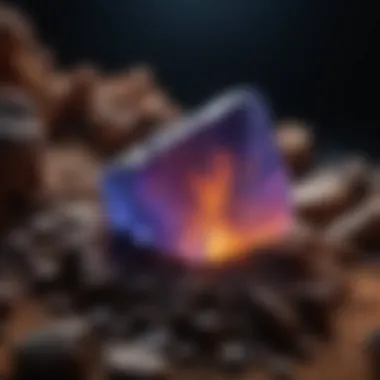
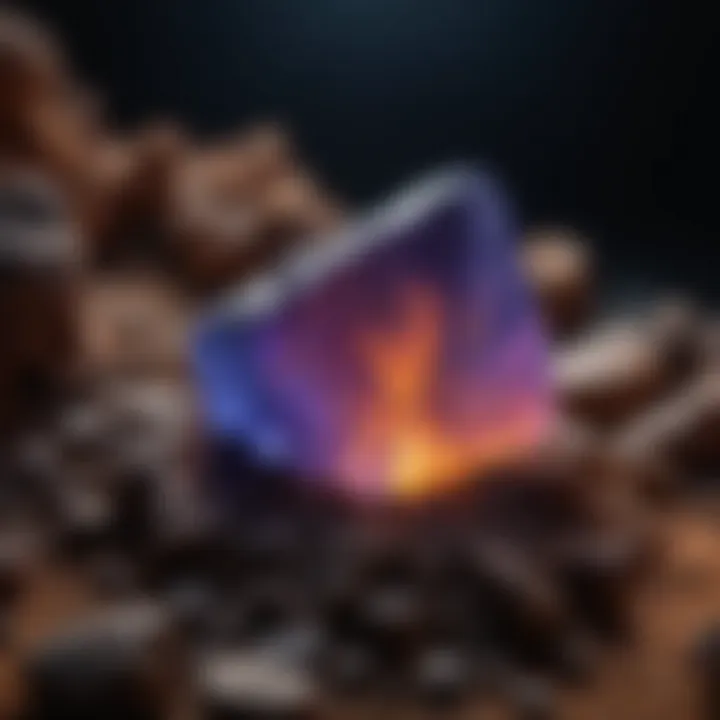
The non-invasive attribute of ultraviolet light testing fosters confidence in its results. With no risk of damaging valuable specimens, this method encourages exploration and experimentation in the field. It opens avenues for further study, allowing researchers to revisit and analyze the same specimen multiple times without any detriment.
Limitations of the Ultraviolet Light Test
Understanding the limitations of the ultraviolet light test is crucial for anyone interested in its applications, particularly in fields like geology and paleontology. While this technique offers valuable insights into mineral identification and fossil integrity, it is not without its challenges. Recognizing these limitations can help researchers and collectors make informed decisions about when and how to apply the test effectively.
Challenges in Interpretation
One significant limitation of the ultraviolet light test pertains to the interpretation of results. The emitted fluorescence can vary greatly depending on multiple factors, including the type of mineral or fossil under observation. For example, certain minerals may exhibit strong fluorescence under ultraviolet light, while others may show none at all. This variability can lead to misinterpretation of results, especially for novices. It is crucial to understand that the mere presence of fluorescence does not equate to the authenticity or quality of a specimen. Furthermore, the intensity of fluorescence can differ based on the energy level of UV light used during testing. Thus, a comprehensive understanding of local geology, along with hands-on experience, is essential to interpret the results accurately.
Material Variability Effects
The second important limitation is the significant effect of material variability on test outcomes. Different specimens can have distinct responses to ultraviolet light due to their chemical composition and historical influences. For instance, fossils that have undergone significant geological processes may not fluoresce as expected. Likewise, synthetic materials can imitate natural specimens, complicating the accurate assessment. This makes it vital to establish a baseline knowledge of which materials are expected to fluoresce and how often exceptions to those norms occur. Additionally, external factors such as contamination or degradation over time can alter the fluorescence properties, leading to potential erratic results.
"A clear understanding of the limitations can optimize the use of ultraviolet light tests and prevent misconceptions about what the fluorescence reveals."
By recognizing these limitations, enthusiasts and professionals can leverage the benefits of the ultraviolet light test while remaining grounded in the realities of its application. This balanced approach ensures that while the technique is a powerful tool, it requires careful consideration and contextual awareness to be truly effective.
Best Practices for Implementation
Utilizing the ultraviolet light test requires attention to several best practices to ensure accuracy and reliability. Implementing these practices is essential for rock and fossil collectors. They help optimize the effectiveness of the testing process, minimize errors, and enhance overall results. Focusing on proper methods will lead to better identification and analysis of geological specimens. Below, we will discuss critical elements for effective implementation, addressing equipment, environmental settings, and documentation.
Choosing the Right Equipment
Selecting appropriate equipment is foundational for performing ultraviolet light tests. Quality equipment enables precise results and minimizes potential interference. Different types of ultraviolet light sources exist, including flashlights and larger lamps.
- Consider the Type of Ultraviolet Light: Decide if UV-A, UV-B, or UV-C is suitable for your purposes. Each type has specific applications depending on what you want to identify within the specimen.
- Assess Power and Intensity: Higher intensity light can produce clearer fluorescences. However, it may also damage sensitive specimens. Therefore, finding a balance between power and delicacy is crucial.
- Look for Specialty Filters: Filters can enhance detection by isolating specific wavelengths, proving beneficial for detailed analysis.
- Check for Portability: For collectors who travel, portable light sources are more convenient. A lightweight device with battery backup may be ideal.
Choosing the right equipment directly impacts the efficacy of the ultraviolet light test.
Setting Up a Controlled Environment
Creating an ideal setting for the test can greatly influence the results. Various environmental factors can lead to distractions or inaccuracies. Thus, a controlled environment is vital.
- Minimize External Light: Conduct the tests in a darkened area to enhance visibility of the fluorescence. This might involve using blackout curtains or a designated room without windows.
- Stabilize the Temperature: Extreme temperatures can affect both specimens and equipment. Maintain a stable room temperature to prevent any deterioration of both.
- Keep the Space Clean: Dust and particulate matter can interfere with results. Regular cleaning of the work surface and equipment prior to conducting tests is necessary.
By addressing these factors, collectors can ensure that the testing environment is conducive to reliable analysis.
Documenting Results
Proper documentation is essential for assessing findings and future reference. Recording results in an organized manner aids in tracking specimen behaviors under ultraviolet light. Effective documentation practices foster clarity and allow for better understanding and sharing of data.
- Use Standardized Formats: Create templates to log observations, noting the conditions, parameters, and any changes seen in specimens under ultraviolet light.
- Incorporate Photographic Evidence: Document findings with photographs. Visual records can assist in affirming hypotheses and findings in future analyses.
- Maintain Records Over Time: Regularly update documentation to reflect ongoing research or new insights. A historical view may unveil patterns previously unnoticed.
- Share Findings with Peers: Engaging with the community through platforms like reddit.com or specialized groups can foster discussion and knowledge sharing.
Ending
The conclusion synthesizes the key elements discussed throughout the article, emphasizing the significance of the ultraviolet light test in various fields, particularly geology and paleontology. Understanding how ultraviolet light can reveal hidden features in minerals and fossils introduces a valuable tool for researchers and collectors alike. The test not only aids in identifying materials but also enhances our comprehension of the natural history encapsulated within these specimens.
Summary of Key Points
- Versatility: The ultraviolet light test serves multiple purposes across disciplines, from assessing mineral authenticity to evaluating fossil integrity.
- Non-invasive: This method requires no physical alteration of the samples, preserving their integrity while allowing for detailed analysis.
- Instrument Calibration: Proper setup and calibration of instruments are fundamental for accurate results, making expertise essential in the application.
- Documenting Findings: Recording observations from tests ensures reliable data that contributes to ongoing research and understanding.
Future Trends in Ultraviolet Light Testing
The future of ultraviolet light testing looks promising with advancements in technology and growing interest in non-invasive research methods. Potential trends include:
- Innovative Instruments: Development of more precise and portable UV devices may enhance fieldwork efficiency.
- Data Analysis: Integrating machine learning algorithms for interpreting UV fluorescence could lead to new insights in material science.
- Cross-disciplinary Applications: Increased collaboration between the fields of geology, archaeology, and art conservation may lead to novel methodologies that leverage UV testing for various applications.
This method is a growing avenue of exploration, offering clearer insights into materials that are often misunderstood or overlooked.



